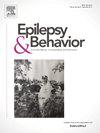Social determinants of health (social risk) and epilepsy in older adults living in low-resource rural settings
IF 2.3
3区 医学
Q2 BEHAVIORAL SCIENCES
引用次数: 0
Abstract
Background
Information of the link between social risk and epilepsy in remote rural settings is limited. This study aims to assess this association in older adults enrolled in the Three Villages Study cohort.
Methods
Following a population-based cross-sectional design, older adults living in rural Ecuador underwent social risk determinations based on social determinants of health components from the Gijon’s Social-Familial Evaluation Scale (SFES) together with clinical interviews to determine epilepsy history. Both unadjusted and multivariate logistic regression models were fitted to assess the association between the total Gijon’s SFES and each of its components and epilepsy (dependent variable).
Results
The study included 682 individuals aged ≥ 60 years (mean age: 68 ± 7.3 years; 55 % women). The mean Gijon’s SFES score was 10.1 ± 3.1 points, and the crude prevalence of epilepsy was 35.1 per 1,000 population. In unadjusted analysis participants in the highest tertile of social risk had significantly higher odds of having epilepsy compared to those in the lowest tertile (OR: 5.37; 95 % C.I.: 1.73 – 16.7). This association persisted when age, sex, and level of education were added to the model. Analysis of individual components of the Gijon’s SFES showed that only social relationships and support networks were significantly associated with epilepsy.
Conclusion
Study results indicate a link between high social risk and epilepsy. The direction of this association remains unclear, but a bidirectional relationship between both variables is likely. Adopting stronger community networks and social support systems could help mitigate epilepsy burden in low-resource settings.

生活在资源匮乏的农村环境中的老年人健康(社会风险)和癫痫的社会决定因素
背景:关于偏远农村地区社会风险与癫痫之间联系的信息有限。本研究旨在评估三村研究队列中老年人的这种关联。方法采用以人群为基础的横断面设计,对生活在厄瓜多尔农村的老年人进行了社会风险评估,该评估基于希洪社会家庭评估量表(SFES)中健康成分的社会决定因素,并与临床访谈一起确定癫痫史。拟合了未调整和多变量logistic回归模型,以评估总Gijon 's sses及其各组成部分与癫痫(因变量)之间的关系。结果纳入年龄≥60岁的患者682例(平均年龄68±7.3岁;55%为女性)。平均Gijon 's sses评分为10.1±3.1分,癫痫粗患病率为35.1 / 1000。在未经调整的分析中,社会风险最高分位数的参与者患癫痫的几率明显高于最低分位数的参与者(OR: 5.37;95% c.i.: 1.73 - 16.7)。当在模型中加入年龄、性别和教育水平时,这种关联仍然存在。对希洪人SFES个体成分的分析表明,只有社会关系和支持网络与癫痫有显著关联。结论研究结果表明高社会风险与癫痫之间存在联系。这种关联的方向尚不清楚,但这两个变量之间可能存在双向关系。采用更强有力的社区网络和社会支持系统可以帮助减轻资源匮乏地区的癫痫负担。
本文章由计算机程序翻译,如有差异,请以英文原文为准。
求助全文
约1分钟内获得全文
求助全文
来源期刊

Epilepsy & Behavior
医学-行为科学
CiteScore
5.40
自引率
15.40%
发文量
385
审稿时长
43 days
期刊介绍:
Epilepsy & Behavior is the fastest-growing international journal uniquely devoted to the rapid dissemination of the most current information available on the behavioral aspects of seizures and epilepsy.
Epilepsy & Behavior presents original peer-reviewed articles based on laboratory and clinical research. Topics are drawn from a variety of fields, including clinical neurology, neurosurgery, neuropsychiatry, neuropsychology, neurophysiology, neuropharmacology, and neuroimaging.
From September 2012 Epilepsy & Behavior stopped accepting Case Reports for publication in the journal. From this date authors who submit to Epilepsy & Behavior will be offered a transfer or asked to resubmit their Case Reports to its new sister journal, Epilepsy & Behavior Case Reports.
 求助内容:
求助内容: 应助结果提醒方式:
应助结果提醒方式:


